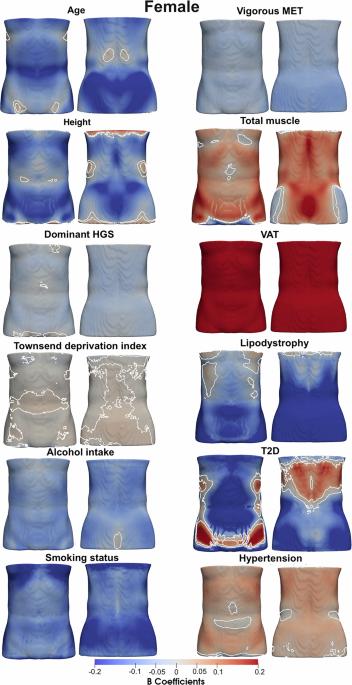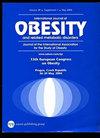Changes in abdominal subcutaneous adipose tissue thickness associate with disease and anthropometric factors
IF 3.8
2区 医学
Q1 ENDOCRINOLOGY & METABOLISM
引用次数: 0
Abstract
Three-dimensional (3D) mesh-derived phenotypes enable detailed characterisation of organ morphology and regional variation through statistical parametric maps (SPMs) and statistical shape analysis (SSA). While these techniques have been widely used for organ studies, their application to abdominal subcutaneous adipose tissue (ASAT) has been limited. This study investigates the associations between ASAT thickness, anthropometric traits, and clinical conditions, including type 2 diabetes (T2D) and hypertension. We analysed ASAT using MRI data from 44,515 participants in the UK Biobank who underwent baseline imaging, with a subset of 3088 participants receiving a follow-up scan approximately 2 years later. ASAT thickness was quantified using 3D surface meshes. Regional associations with anthropometric and clinical variables were examined using SPMs. Additionally, principal components of ASAT thickness, derived via SSA, were analysed for their association with future cardiovascular disease (CVD) risk. ASAT thickness was significantly associated with age, alcohol consumption, visceral fat, total muscle mass, and various health-related traits. Longitudinal analysis revealed significant changes in ASAT thickness over a 2.5-year period in both sexes, independent of disease status at baseline. Notably, regional variations in hip ASAT thickness were associated with incident CVD in women (hazard ratio [HR]: 0.90, 95% CI: 0.84–0.97, p = 0.023) and with hypertension in both women (HR: 1.10, 95% CI: 1.03–1.21, p = 0.045) and men (HR: 0.88, 95% CI: 0.82–0.96, p = 0.014). 3D quantification and morphometric analysis of ASAT offer novel insights into the associations between abdominal fat distribution, lifestyle factors, and chronic disease risk. These techniques hold promise for enhancing our understanding of fat-related disease mechanisms in population-level studies.

腹部皮下脂肪组织厚度的变化与疾病和人体测量因素有关。
背景:三维(3D)网格衍生表型可以通过统计参数图(SPMs)和统计形状分析(SSA)详细描述器官形态和区域变化。虽然这些技术已广泛用于器官研究,但它们在腹部皮下脂肪组织(ASAT)中的应用受到限制。本研究探讨了ASAT厚度、人体测量特征和临床状况(包括2型糖尿病(T2D)和高血压)之间的关系。方法:我们使用来自英国生物银行44,515名参与者的MRI数据分析ASAT,这些参与者接受了基线成像,其中3088名参与者在大约2年后接受了随访扫描。采用三维曲面网格量化ASAT厚度。使用SPMs检查与人体测量和临床变量的区域关联。此外,通过SSA得出ASAT厚度的主要成分,分析了它们与未来心血管疾病(CVD)风险的关系。结果:ASAT厚度与年龄、酒精摄入量、内脏脂肪、总肌肉质量和各种健康相关特征显著相关。纵向分析显示,在2.5年的时间里,男女ASAT厚度发生了显著变化,与基线时的疾病状况无关。值得注意的是,髋部ASAT厚度的区域差异与女性心血管疾病(风险比[HR]: 0.90, 95% CI: 0.84-0.97, p = 0.023)和女性高血压(风险比:1.10,95% CI: 1.03-1.21, p = 0.045)和男性高血压(风险比:0.88,95% CI: 0.82-0.96, p = 0.014)相关。结论:ASAT的三维量化和形态计量学分析为腹部脂肪分布、生活方式因素和慢性疾病风险之间的关系提供了新的见解。这些技术有望在人群水平的研究中增强我们对脂肪相关疾病机制的理解。
本文章由计算机程序翻译,如有差异,请以英文原文为准。
求助全文
约1分钟内获得全文
求助全文
来源期刊

International Journal of Obesity
医学-内分泌学与代谢
CiteScore
10.00
自引率
2.00%
发文量
221
审稿时长
3 months
期刊介绍:
The International Journal of Obesity is a multi-disciplinary forum for research describing basic, clinical and applied studies in biochemistry, physiology, genetics and nutrition, molecular, metabolic, psychological and epidemiological aspects of obesity and related disorders.
We publish a range of content types including original research articles, technical reports, reviews, correspondence and brief communications that elaborate on significant advances in the field and cover topical issues.
 求助内容:
求助内容: 应助结果提醒方式:
应助结果提醒方式:


